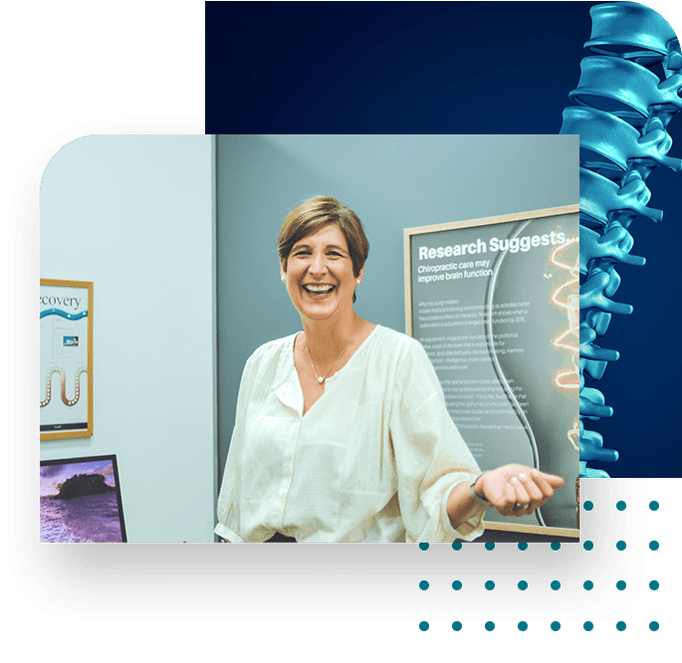'Don't let urgency consume all the energy you have.'
Second Quarter 2024
(Apr to Jun)
Volume 4, Issue 4 (4.4)
Freedom of thought and discussion
The war for control of Chiropractic is taking place inside our heads: Moments of Truth, or: Does the Canadian wackiness ever end? Will Hong Kong’s new college be killed by The British Empire’s ‘old guard’? and When will you sell-out to Amazon?
Abstract: Elsewhere in this issue I state ‘Chiropractic is the diagnosis and management of the neuromusculoskeletal system of the human body’ and discuss the emergent problem of an increasing shrinkage of the constitutional framework of the discipline where current arguments continue to remove reference to subluxation from the profession’s lexicon, even flagitiously mandating against teaching the idea within its natural context.
In this editorial I give some examples of the good work being done to carry our profession to greatness, and balance that with some examples of wackiness from Canada and the United States of America, and once again from the usual dismal suspects in Europe.
I am starting to think that Australia is one of the better places in the world to practice Conventional Chiropractic, yet offer caution that this may be about to change.
Above all I hold that a Chiropractor carries spontaneous unspoken trust in what they see and feel, and conclude with a marvellous video of a Philosophy discussion about how strongly we can ‘know things’ from our patient’s testimony.
Indexing Terms: chiropractic; subluxation; Canada; Hong Kong; Amazon; patient testimony; ethics.
Cite: Ebrall P. The war for control of Chiropractic is taking place inside our heads: Moments of Truth, or: Does the Canadian wackiness ever end? Will Hong Kong’s new college be killed by The British Empire’s ‘old guard’? and When will you sell-out to Amazon? Asia-Pac Chiropr J. 2024;4.4. apcj.net/papers-issue-4-4/#EbrallEditorialApr24
The importance of Evidence-Based Practice and clinical competence in Chiropractic care
Narrative: We live in an Age where Medical misconceptions, misinterpretations of research findings, and the dissemination of unverified claims have the potential to undermine evidence-based practice and compromise patient care.
By ardently embracing evidence-based practice, nurturing clinical competence, nurturing critical thinking, and fostering collaboration, we can safeguard the sanctity of patient care and fortify the edifice of modern medicine against the perils of misinformation
Indexing terms: Chiropractic; World Congress of Chiropractic Students, WCCS; Leadership; information literacy.
Cite: Ebrahim A. The importance of Evidence-Based Practice and clinical competence in Chiropractic care [WCCS]. Asia-Pac Chiropr J. 2024;4.4. apcj.net/papers-issue-4-4/#EbrahimEBM
Gleb Kirdoglo: Manual muscle testing, Clinical Atlas [Review]
Narrative: This new Clinical Atlas for the specialist skill of Applied Kinesiology practitioners is a miracle from a war zone.
It is strongly written and beautifully illustrated showing the detailed anatomy, biomechanics, and testing of over 50 skeletal muscles.
The author includes algorithms kinesitherapy and kinesiotaping for specific muscle dysfunctions.
It is a ‘must have’ for every AK practitioner.
Indexing Terms: Chiropractic; AK; Applied Kinesiology; Kirdoglo Atlas.
Cite: Cuthbert S. Gleb Kirdoglo: Manual muscle testing, Clinical Atlas [Review]. Asia-Pac Chiropr J. 2024;4.4. apcj.net/papers-issue-4-4/#CuthbertKirdogloReview
Note from Maksym Malynov, CEO of the United Association of applied kinesiology: Today, the Book is presented in three languages: Russian, English and German. In addition, a publishing house in Poland received the rights to publish the book in Polish.
The book is published in Russia by Phoenix Publishing House (the publishing contract was concluded before the start of the war).
The book is published in English and German by our association in Ukraine. That is why we continue to look for publishing partners in Europe and the USA to publish the book on a global level.
Editor’s note: The fighting in Ukraine continues with significant disruptions. We suggest our AK readers use their international contacts to track down a copy art this time. We will advise on our Home page the details of a global publisher when known.
You can order here: https://seminar.ua-pk.com/atlas-en
Temporal Bone Cranial Dysfunctions:
A resume of ‘The Trouble Maker of The Head’ with a focus on prevalent Vestibulo-Ocular Proprioceptive Syndromes in Chiropractic Practice
Narrative: Here I discuss the vertebral subluxation, temporal bone cranial dysfunctions, and equilibrium syndromes and show their association via sensory conflict and dysponesis.
The hypothesis derived from clinical and anatomic observations is that the nervous system operating within the disturbed geometric forms and mechanisms of patients with temporal bone cranial dysfunctions will not operate properly.
The examination and treatment of the cranial mechanism, along with other chiropractic procedures that improve proprioceptive signalling throughout the body, assume a new significance and even greater importance than was formerly appreciated.
Indexing Terms: Chiropractic; AK; Applied Kinesiology; proprioception; tone, Temporal bone; dysponesis.
Cite: Cuthbert S. Temporal Bone Cranial Dysfunctions: A resume of ‘The Trouble Maker of The Head’ with a focus on prevalent Vestibulo-Ocular Proprioceptive Syndromes in Chiropractic Practice. Asia-Pac Chiropr J. 2024;4.4. apcj.net/papers-issue-4-4/#CuthbertTemporalBone
Sacro Occipital Technique (SOT): A Systems Driven Method of Chiropractic
Narrative: In this paper I give the principles for each of the three Categories applied within Sacro Occipital Technique (SOT) and show how these relate to each of the three primary systems of the body
DeJarnette was a researcher, author, teacher and developer of the SOT systems method of Chiropractic and the principles he gave underpin a clinically solid and successful approach to patient care.
A system strives for equilibrium, a point of balance, a state in which all components of the system are in a state of harmony. The SOT practitioner strives to achieve harmony and balance amongst these three systems of the body.
Indexing Terms: Sacro Occipital Technique; Chiropractic; Function; Systems’ SOT Categories; SOT Indicators; Objectivity.
Cite: Getzoff H. Sacro Occipital Technique (SOT): A Systems Driven Method of Chiropractic. Asia-Pac Chiropr J. 2024;4.4. apcj.net/Papers-Issue-4-4/#GetzoffSOTSystem
One element of a subluxation complex: Disruption of articular motion through the intervertebral foramen influencing the IVF, CSF, and neural transmission [Hypothesis]
Narrative: This report discusses possible factors thought to alter nerve transmission as influenced by segmental mechanical disturbance being one of the elements in a Vertebral Subluxation Complex (VSC). In addition to noxious sensory input, this discussion raises the possibility of the following physical modifier under the influence of segmental biomechanical disturbance.
We hypothesise on the potential influence of an intersegmental functional fixation effect on vascular and Cerebrospinal Fluid (CSF) circulation may have on neural function within the Intervertebral Foramen (IVF).
As the adjacent lips of articular facets form a part of the IVF margin, it is proposed here that the intersegmental articular fixation element of a VSC has the potential to also limit motion within the foramen, and potentially modify the flow of CSF within the neural sleeves which bathe the spinal nerve roots. We speculate that the effect of the fixation may lead to CSF stasis, or at least reduced CSF circulation within that radicular setting. In turn, that this may effect the spinal nerve root neurons and nerve transmission. Telano & Baker (2022) and Whedon and Glassey (2009) state that CSF ‘appears to be particularly prone to stasis due to the relatively high capacitance of the lumbar cistern and lower intrathecal pressures in the distal spinal canal.
Indexing Terms: Chiropractic; Vertebral Subluxation Complex; Subluxation; IVF; Intervertebral foramen; CSF; Hypothesis.
Cite: Rome PL, Waterhouse JD. One element of a subluxation complex: Disruption of articular motion through the intervertebral foramen influencing the IVF, CSF, and neural transmission [Hypothesis]. Asia-Pacific Chiropr J. 2024;4.4. apcj.net/papers-issue-4-4/#RWHypothesis
Editors note: Read this paper along with Pessa’s report (Plast Reconstr Surg Glob Open 2022;10:e4126; DOI 10.1097/GOX.0000000000004126) discussed in the Editorial of this issue regarding CSF within neural sheaths throughout the body.
Management of common clinical syndromes of the Low Back and Pelvis
Narrative: The interplay of bony, muscular, and ligamentous structures about the low back and pelvis can present a challenge to the Chiropractor to accurately diagnose and correct.
Here I present a selection of common clinical findings of this region and describe my diagnostic approach which uncovers the source of the issue to allow its effective treatment.
The technique of choice is the NeuroImpulse Protocol,™ a low force technique which is very specific in its application.
This paper is taken from Module 1 of the NeuroImpulse learning materials© and manual and provides the busy practitioner with a clean and tidy clinical approach to what are frequently difficult problems to resolve.
Indexing Terms: Chiropractic, Clinical management; Low Back; Pelvis; NeuroImpulse Protocol.
Cite: Davies NJ. Management of common clinical syndromes of the Low Back and Pelvis. Asia-Pac Chiropr J. 2024;4.4. apcj.net/papers-issue-4-4/#DaviesLowBackPelvis
The Grand Deception: Any diagnosis of ‘non-specific’ low back pain
Narrative abstract: Undeniably ‘bad disks’ seen on x-rays and MRI scans have been used as effective selling points to gullible patients that have greatly increased the number of unnecessary surgeries at an enormous cost and waste according to a Stanford study. This study also found increased surgery rates do not improve patient outcomes. Back surgery rates are highest where MRIs are the highest.
The presence of a herniated disk also does not warrant the need for surgery until conservative care has been tried. In 2010 the North American Spine Society journal suggested spine fusion should be a last resort and recommended that spinal manipulation, 5 to 10 sessions over 2 to 4 weeks, should be considered before surgery. Undeniably ‘bad disks’ seen on x-rays and MRI scans have been used as effective selling points to gullible patients that have greatly increased the number of unnecessary surgeries at an enormous cost and waste.
When medical radiologists read images through a medical lens which is on trained on the subtleties familiar to Chiropractors, the label the problem as ‘uncomplicated’ and ‘nonspecific’ rather than admitting they simply had no idea why these people were in pain and have no realistic ideas how to help them other than prescribing dangerous opioid painkillers, which becomes a slippery slope to worse when it results in abuse, addiction, and spine surgery.
Indexing terms: Chiropractic; LBP; Diagnosis; low back pain; back surgery.
Cite: Smith JC. The Grand Deception: Any diagnosis of ‘non-specific’ low back pain. Asia-Pac Chiropr J. 2024;4.4 URL apcj.net/Papers-Issue-4-4/#SmithGrandDeception
Channelling healing energy: Anatomical variants and our patients, Part six.
Narrative abstract: While humans have a similar architecture with a head, torso, two arms and legs, we are as dissimilar as are snowflakes. We each carry anatomical variances, all significant to the application of manual care.
Similarly, we all have variations in our psychological processing and functioning but one thing has been found to be consistent.
In the 1970s I explored biofeedback and meditation with Jack Garris, performing various types of meditations, self-hypnosis, and relaxation exercises and monitored their affects on our EEG, EMG, and temperature feedback. We never saw one form of biofeedback not influence the other, which emphasised to me that clearly our mind and body were inseparable. Garris would often say that we can’t have a tense body with a relaxed mind and likewise we can’t have an anxious mind when we have a relaxed body.
This is to be remembered as we look for optimal ways to channel our healing energy. It is important with our chiropractic encounters that we understand that all our patients are different, both physically and psychologically.
Indexing terms: Chiropractic; chiropractor; anatomical variance; relaxation; healing energy.
Cite: Blum CL. Channelling healing energy: Anatomical Variants and our Patients, Part six. URL Asia-Pac Chiropr J. 2024;4.4 apcj.net/Papers-Issue-4-4/#BlumHealingEnergy6
The nature of the Subluxation and the simple elegant complexity of The Adjustment: Not your Grandfather’s waterhose
Abstract: Purpose: To provide a scientific report using peer-reviewed scientific papers that will demonstrate the implications of brain function and plasticity and its correlation to Subluxation and hence the implications of brain function enhancement through chiropractic adjustments.
Methods: Analysis was undertaken of the literature reporting on brain plasticity related to brain function and its dependance on chemical changes within the brain. These were found to be highly related to a wide array of clinical outcomes. The literature demonstrates that now we can identify the chemical changes within the brain that are highly related to the same peripheral changes and central nervous system changes that we see with subluxation. Hence, the literature goes on to indicate that correction of these peripheral changes and central nervous system changes will in fact create changes in the biochemical function in the brain affecting brain plasticity for the better. It is inferred that the correction of brain plasticity will have outcomes affecting the entire body including brain function itself improving conditions such as anxiety, depression, addiction, personality conflicts, and learning disabilities. There is a question as well in most literature where it is suggested that changes in the brain chemistry and plasticity could very well aid in other problems such as MS, Alzheimer’s, Parkinson’s, etc.
Conclusions: It is reported here that there is a strong apparent connection between brain plasticity neurochemistry and Subluxation. We put forward that the chiropractic adjustment making changes in this neurochemistry will represent a profound change in brain plasticity, function, and learning. Further studies concerning this topic are needed to further corroborate our observations.
Indexing Terms: chiropractic; spinal adjustment; epigenetics; neuroplasticity; Dysponesis; zygapophysial joint.
Cite: Weiner G. The nature of the Subluxation and the simple elegant complexity of The Adjustment: Not your Grandfather’s waterhose. Asia-Pac Chiropr J. 2024;4.4. apcj.net/Papers-Issue-4-4/#WeinerAdjustment
Subluxation as a fuzzy narrative
Abstract: Chiropractic is the diagnosis and management of the neuromusculoskeletal system of the human body with the emergent problem of an increasing shrinkage of the constitutional framework of the discipline where current arguments continue to remove reference to subluxation from the profession’s lexicon, even flagitiously mandating against teaching the idea within its natural context.
The challenge I address in this paper are my observations that subluxation on the one hand is not real as a materialist would want it to be, yet is alive and well in the majority of practices globally where fully-trained Chiropractors address and resolve this clinical entity many times a day.
I hold that a Chiropractor carries spontaneous unspoken trust in what they see and feel, with the paradox that they can only convey this by constructing and conducting fuzzy narratives. Narration conveys the idea of the Chiropractor’s perspectival truth of a particular subluxation in a particular patient, to allow correction by hand in a manner which the patient understands and accepts as their clinical reality.
Indexing Terms: chiropractic; subluxation; narrative; narration; ethics; Rawlsian social contract.
Cite: Ebrall P. Subluxation as a fuzzy narrative. Asia-Pac Chiropr J. 2024;4.4. apcj.net/papers-issue-4-4/#EbrallFuzzyNarrative
Dentofacial orthopaedics and maxillary morphogenesis: A case series
Introduction: Three adult case reports (79 and 60 years old females and a 60 year old male) were selected to demonstrate maxillary morphogenesis. These patients were treated for maxillary underdevelopment which can affect occlusion and airway space due to the relationship between the tongue and the hard palate.
Intervention: Each patient wore the Homeoblock™ appliance for a minimum of twelve months. The Homeoblock™ consists of ‘Adams clasps’ on the bicuspids with a baseplate that incorporates a palatal expansion jack screw. The appliance is relieved from the palatal tissues. Flap springs rest on the anterior teeth and a Hawley arch wire extends from left to right canine. A bite block is placed on the second bicuspid and first molar on the less developed side.
Results: Improved tongue position, tone, and the resulting increased pharyngeal airway size were found with each patient.
Discussion: Once nurture seemed clearly distinct from nature. External influences seem to be able to influence a network of chemical switches within our cells collectively known as the epigenome.
Conclusion: These three cases demonstrated how modifications of tissues in the craniofacial region can occur with adult patients in their 6th and 7th decade of life.
Indexing terms: Chiropractic; chiropractor; tongue; hard palate; dentofacial; maxillary morphogenesis; Homeoblock™
Cite: Belfor TR, Blum CL. Dentofacial orthopaedics and maxillary morphogenesis: A case series. Asia-Pac Chiropr J. 2024;4.4 apcj.net/Papers-Issue-4-4/#BelforBlumDentofacial
Improvement in sleep, mental health, heavy metal toxicity and adaptability concomitant with Chiropractic care in a 47-year-old female cancer-patient undergoing chemotherapy: A Case Report
Background: A 47-year-old female patient with stage four breast cancer and lymphatic involvement, as well as several secondary physical complaints and psychological stressors, presented for chiropractic care following six sessions of chemotherapy. This was her second bout with cancer, having survived Hodgkins Lymphoma.
Intervention: The patient underwent three, five-day courses of concentrated chiropractic care with complementary care modalities, in addition to her oncological treatment plan.
Outcomes: The patient was able to achieve full remission of her cancer as well as marked improvements in sleep, mental health, and physical adaptability.
Conclusion: This case report provides an impetus for further investigations into chiropractic care and cancer, especially heavy metal toxicity, cancer, and chiropractic care.
Indexing Terms: Chiropractic; Subluxation; breast cancer; Hodgkin’s lymphoma; concentrated care; Quality of Life.
Cite: Kotlerman S, Martin A, Carter M, Postlethwaite R, McIvor C. Improvement in sleep, mental health, heavy metal toxicity and adaptability concomitant with Chiropractic care in a 47-year-old female cancer-patient undergoing chemotherapy: A Case Report. Asia-Pac Chiropr J. 2024;4.4. apcj.net/Papers-Issue-4-4/#AverioChemotherapy
Improved sleep, mood and physical resilience and decreased pain in a 46-year-old female under chiropractic care: A Case Report
Background: A 46-year-old female presented for chiropractic care with pain in the pelvis following a motor vehicle accident one year prior. At the time of presentation, she had severely limited physical resilience, limited ability to walk, lie down or stay in one position for too long, and she had a long medical history of other physical health problems.
Management: The patient commenced chiropractic care, to which she was a novice, in the hopes of achieving reduced pain. She commenced a 12-session care plan and was adjusted using Torque Release Technique, with Instrument-assistant (integrator), Manual adjustments (HVLA), SOT blocks (pelvic region), Drop table (sacro-pelvic region) and Toggle board (upper cervical region).
Outcome: After 12 sessions of chiropractic care, she reported increased sleep, mood, energy and physical functioning, decreased pain, decreased dermatitis, increased digestive function and reported that she felt more alive than she had in years.
Indexing Terms: Chiropractic; Subluxation; Torque Release Technique; resilience; dermatitis.
Cite: Steinberg B, Clodgo-Gorden K, Postlethwaite R, McIvor C. Improved sleep, mood and physical resilience and decreased pain in a 46-year-old female under chiropractic care: A case report. Asia-Pac Chiropr J. 2024;4.4. apcj.net/papers-issue-4-4/#SteinbergResilience
Improvement in digestive health in a 24-year-old male under Chiropractic care: A case report
Background: A 24-year-old male elite athlete presented for care with primary concerns of Irritable Bowel Syndrome symptoms that had not resolved or improved under traditional medical care.
Management: The patient was managed using Advanced Bio-Structural Correction Technique, including Meningeal releases, in assessing and correcting subluxation.
Outcomes: A 70% improvement in symptoms was reached during the first four weeks of care, with full resolution of symptoms soon after.
Indexing Terms: Chiropractic; Subluxation; Irritable Bowel Syndrome; salutogenesis.
Cite: Leahy AE, Postlethwaite R, McIvor C. Improvement in digestive health in a 24-year-old male under Chiropractic care: A case report. Asia-Pac Chiropr J. 2024;4.4. apcj.net/papers-issue-4-4/#LeahyDigestiveHealth
Restored heart function and reduced recovery time in a 36-year-old female patient following a Pulmonary Embolism and induced coma: A case report
Background: A fit, healthy, regularly adjusted 36-year-old female suffered a pulmonary embolism following a long haul flight from the USA. Emergency Medical care included intubation and an induced coma before discharge at which point she underwent an intensive regime of Chiropractic care.
Intervention: While the patient considered she was lucky to have survived the incident at all, post hospital discharge she opted for Chiropractic care. This was provided using diversified technique, Thompson and drop piece adjusting techniques was deployed following discharge from hospital. This regime of care aligned with the patient’s Chiropractic philosophy.
Outcome: The patient was fully recovered within three weeks of discharge from hospital, with heart function within normal limits. Given the life-threatening nature of the incident, and the normal recovery time for such patients, we feel this is significant and may provide rationale for further study into Chiropractic care and improved recovery times.
Indexing Terms: Chiropractic; Subluxation; pulmonary embolism; salutogenesis; Philosophy.
Cite: Luu J, Atkinson B, Postlethwaite R, McIvor C. Restored heart function and reduced recovery time in a 36-year-old female patient following a Pulmonary Embolism and induced coma: A case report. Asia-Pac Chiropr J. 2024;4.4. apcj.net/papers-issue-4-4/#LuuPE
Decreased thigh pain and increased mental acuity and physical performance in a 26-year-old male under Chiropractic care: A case report
Background: A 26-year old male testicular cancer survivor presented for Chiropractic care with a primary complaint of intermittent thigh pain.
Intervention: The patient underwent a course of subluxation-based Chiropractic care during which he was checked and adjusted using Advanced Bio-Structural Correction Technique.
Outcome: Despite a singular presenting concern of intermittent thigh pain from an four-year-old injury, he returned numerous other positive outcomes he attributed to Chiropractic.
This presents numerous questions as to the body’s state of adaptability even years after cancer, and the role Chiropractic may play in building up this adaptability again over time.
Indexing Terms: Chiropractic; Subluxation; mental acuity; testicular cancer; thigh pain; adaptability.
Cite: Hawkes D, Postlethwaite R, McIvor C. Decreased thigh pain and increased mental acuity and physical performance in a 26-year-old male under Chiropractic care: A case report. Asia-Pac Chiropr J. 2024;4.4. apcj.net/papers-issue-4-4/#HawkesMentalAcuity
Disclaimer
This journal is a professional journal by chiropractors for chiropractors. Readers not fully trained as a chiropractor should not act on their own on any information published in these pages and should always discuss their situation with their chiropractor.













